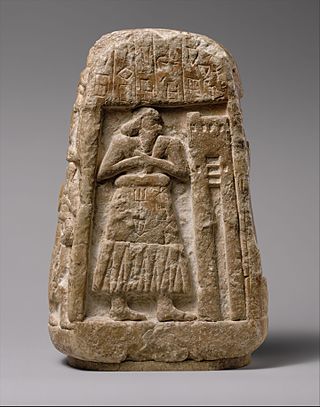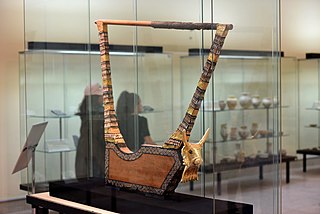Related Research Articles

Ninḫursaĝ sometimes transcribed Ninursag, Ninḫarsag, or Ninḫursaĝa, also known as Damgalnuna or Ninmah, was the ancient Sumerian mother goddess of the mountains, and one of the seven great deities of Sumer. She is known earliest as a nurturing or fertility goddess. Temple hymn sources identify her as the "true and great lady of heaven" and kings of Lagash were "nourished by Ninhursag's milk". She is the tutelary deity to several Sumerian leaders.

Inanna is the ancient Mesopotamian goddess of love, war, and fertility. She is also associated with sensuality, procreation, divine law, and political power. Originally worshipped in Sumer, she was known by the Akkadian Empire, Babylonians, and Assyrians as Ishtar. Her primary title is "the Queen of Heaven".

Ninsun was a Mesopotamian goddess. She is best known as the mother of the hero Gilgamesh and wife of deified legendary king Lugalbanda, and appears in this role in most versions of the Epic of Gilgamesh. She was associated with Uruk, where she lives in this composition, but she was also worshiped in other cities of ancient Mesopotamia, such as Nippur and Ur, and her main cult center was the settlement KI.KALki.

Damgalnuna, also known as Damkina, was a Mesopotamian goddess regarded as the wife of the god Enki. Her character is poorly defined in known sources, though it is known that like her husband she was associated with ritual purification and that she was believed to intercede with him on behalf of supplicants. Among the deities regarded as their children were Nanshe and Asalluhi. While the myth Enki and Ninhursag treats her as interchangeable with the goddess mentioned in its title, they were usually separate from each other. The cities of Eridu and Malgium were regarded as Damgalnuna's cult centers. She was also worshiped in other settlements, such as Nippur, Sippar and Kalhu, and possibly as early as in the third millennium BCE was incorporated into the Hurrian pantheon. She appears in a number of myths, including the Enūma Eliš, though only a single composition, Damkina's Bond, is focused on her.

Nanaya was a Mesopotamian goddess of love closely associated with Inanna.

Ninshubur, also spelled Ninšubura, was a Mesopotamian goddess whose primary role was that of the sukkal of the goddess Inanna. While it is agreed that in this context Ninshubur was regarded as female, in other cases the deity was considered male, possibly due to syncretism with other divine messengers, such as Ilabrat. No certain information about her genealogy is present in any known sources, and she was typically regarded as unmarried. As a sukkal, she functioned both as a messenger deity and as an intercessor between other members of the pantheon and human petitioners.
Ningikuga was a Mesopotamian goddess. Her name can be explained as nin-gi-kug-a(k), "lady of the pure reed".

Shara was a Mesopotamian god associated with the city of Umma and other nearby settlements. He was chiefly regarded as the tutelary deity of this area, responsible for agriculture, animal husbandry, and irrigation, but he could also be characterized as a divine warrior. In the third millennium BCE, his wife was Ninura, associated with the same area, but later, in the Old Babylonian period, her cult faded into obscurity, and Shara was instead associated with Usaḫara or Kumulmul. An association between him and Inanna is well attested. In Umma, he was regarded as the son of Inanna of Zabalam and an unknown father, while in the myth Inanna's Descent to the Underworld, he is one of the servants mourning her temporary death. He also appears in the myth of Anzû, in which he is one of the three gods who refuse to fight the eponymous monster.
Ninegal or Belat Ekalli (Belet-ekalli) was a Mesopotamian goddess associated with palaces. Both her Sumerian and Akkadian name mean "lady of the palace."

Geshtinanna was a Mesopotamian goddess best known due to her role in myths about the death of Dumuzi, her brother. It is not certain what functions she fulfilled in the Mesopotamian pantheon, though her association with the scribal arts and dream interpretation is well attested. She could serve as a scribe in the underworld, where according to the myth Inanna's Descent she had to reside for a half of each year in place of her brother.

Ninisina was a Mesopotamian goddess who served as the tutelary deity of the city of Isin. She was considered a healing deity. She was believed to be skilled in the medical arts, and could be described as a divine physician or midwife. As an extension of her medical role, she was also believed to be capable of expelling various demons. Her symbols included dogs, commonly associated with healing goddesses in Mesopotamia, as well as tools and garments associated with practitioners of medicine.
Ashgi was a Mesopotamian god associated with Adab and Kesh. While he was originally the tutelary deity of the former of these two cities, he was eventually replaced in this role by his mother Ninhursag, locally known under the name Digirmah. He is mostly attested in sources from before the Old Babylonian period.

Sukkal was a term which could denote both a type of official and a class of deities in ancient Mesopotamia. The historical sukkals were responsible for overseeing the execution of various commands of the kings and acted as diplomatic envoys and translators for foreign dignitaries. The deities referred to as sukkals fulfilled a similar role in mythology, acting as servants, advisors and envoys of the main gods of the Mesopotamian pantheon, such as Enlil or Inanna. The best known sukkal is the goddess Ninshubur. In art, they were depicted carrying staves, most likely understood as their attribute. They could function as intercessory deities, believed to mediate between worshipers and the major gods.
Ninmug or Ninmuga was a Mesopotamian goddess. She was associated with artisanship, especially with metalworking, as evidenced by her epithet tibira kalamma, "metalworker of the land." She could also be regarded as a goddess of birth and assistant of Ninmah, most likely because the fashioning of statues of deities and the birth of children could be described with the same terms in Sumerian texts. Her main cult centers were Kisiga, whose location remains uncertain, and Adab.

Ningizibara, also known as Igizibara and Ningizippara, was a Mesopotamian goddess associated with the balaĝ instrument, usually assumed to be a type of lyre. She could be regarded both as a physical instrument and as a minor deity. In both cases, she was associated with the goddess Inanna. A connection between her and the medicine goddess Gula is also attested, and it is possible she could serve as a minor healing deity herself.
Ninsikila was a Mesopotamian deity regarded as the spouse of Lisin. Early sources refer to him as male, but later on the name came to refer to a goddess instead. The change in gender might have been influenced by an association with the Dilmunite goddess Meskilak, also called Ninsikila in Mesopotamia, or by Lisin's placement before her spouse in god lists. Texts attesting the worship of Ninsikila include an inscription from Larsa and a magical formula from Meturan.
Aruru was a Mesopotamian goddess. The origin of her name is presently uncertain. While initially considered an independent deity associated with vegetation and portrayed in hymns as violent, she eventually came to be viewed as analogous Ninhursag. Her name could also function as an epithet of goddesses such as Nisaba and Ezina-Kusu. She was often called the older sister of Enlil. Her cult centers most likely were the cities of Kesh, Adab and Irisaĝrig. She appears in a number of literary texts, some of which preserve information about her original character. She is also present in the Epic of Gilgamesh, which portrays her as the creator of Enkidu.

Epithets of Inanna were titles and bynames used to refer to this Mesopotamian goddess and to her Akkadian counterpart Ishtar. In Mesopotamia, epithets were commonly used in place of the main name of the deity, and combinations of a name with an epithet similar to these common in ancient Greek religion are comparatively uncommon. Inanna had more titles than any other Mesopotamian deity. They pertained to her associations with specific cities or areas, such as Uruk, Zabalam, Akkad, Nineveh, or the Sealand. Others instead highlighted her specific roles, for example, that of an astral goddess personifying the planet Venus—or that of a war deity. In some cases, her individual epithets eventually developed into separate deities.

Inanna of Zabalam was a hypostasis of the Mesopotamian goddess Inanna associated with the city of Zabalam. It has been proposed that she was initially a separate deity, perhaps known under the name Nin-UM, who came to be absorbed by the goddess of Uruk at some point in the prehistory of Mesopotamia and lost her unknown original character in the process, though in certain contexts she nonetheless could still be treated as distinct. She was regarded as the mother of Shara, the god of Umma, a city located near Zabalam.
References
- ↑ Jacobsen & Kramer 1953, p. 168.
- 1 2 3 4 5 Schwemer 2001, p. 90.
- 1 2 3 4 5 6 Asher-Greve & Westenholz 2013, p. 50.
- ↑ Ceccarelli 2019, p. 118.
- 1 2 Cavigneaux & Krebernik 1998, p. 336.
- ↑ Asher-Greve & Westenholz 2013, pp. 7–8.
- ↑ Ceccarelli 2019, p. 117.
- ↑ Gabbay 2020, p. 78.
- 1 2 3 Jacobsen & Kramer 1953, p. 163.
- ↑ Tinney 2018, p. 86.
- ↑ Litke 1998, p. 165.
- ↑ Jacobsen & Kramer 1953, pp. 163–164.
- 1 2 Jacobsen & Kramer 1953, p. 164.
- ↑ Jacobsen & Kramer 1953, pp. 164–165.
- ↑ Jacobsen & Kramer 1953, p. 179.
- ↑ Tinney 2018, p. 88.
Bibliography
- Asher-Greve, Julia M.; Westenholz, Joan G. (2013). Goddesses in Context: On Divine Powers, Roles, Relationships and Gender in Mesopotamian Textual and Visual Sources (PDF). ISBN 978-3-7278-1738-0.
- Cavigneaux, Antoine; Krebernik, Manfred (1998), "Nin-Bilulu", Reallexikon der Assyriologie (in German), retrieved 2022-12-04
- Ceccarelli, Manuel (2019). "Die ‚Alte Weise' und die ‚weise Frau' im alten Mesopotamien". Fabula. 60 (1–2). Walter de Gruyter GmbH: 100–131. doi:10.1515/fabula-2019-0008. ISSN 1613-0464.
- Gabbay, Uri (2020). "A New Manuscript of Ninĝišzida's Journey to the Netherworld". Altorientalische Forschungen. 47 (1). Walter de Gruyter GmbH: 67–90. doi:10.1515/aofo-2020-0005. ISSN 2196-6761.
- Jacobsen, Thorkild; Kramer, Samuel N. (1953). "The Myth of Inanna and Bilulu". Journal of Near Eastern Studies. 12 (3). University of Chicago Press: 160–188. ISSN 0022-2968. JSTOR 542698 . Retrieved 2022-12-04.
- Litke, Richard L. (1998). A reconstruction of the Assyro-Babylonian god lists, AN:dA-nu-um and AN:Anu šá Ameli (PDF). New Haven: Yale Babylonian Collection. ISBN 978-0-9667495-0-2. OCLC 470337605.
- Schwemer, Daniel (2001). Die Wettergottgestalten Mesopotamiens und Nordsyriens im Zeitalter der Keilschriftkulturen: Materialien und Studien nach den schriftlichen Quellen (in German). Wiesbaden: Harrassowitz. ISBN 978-3-447-04456-1. OCLC 48145544.
- Tinney, Steve (2018). ""Dumuzi's Dream" Revisited". Journal of Near Eastern Studies. 77 (1). University of Chicago Press: 85–89. doi:10.1086/696146. ISSN 0022-2968.